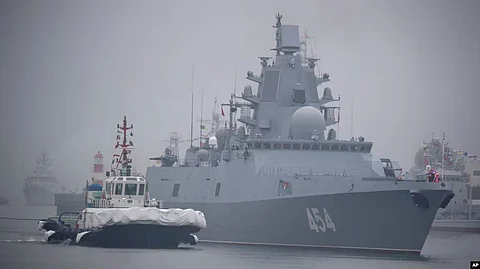
- Home
- न्यूजग्राम
- India
- World
- Politics
- Entertainment
- Culture
- Lifestyle
- Economy
- Sports
- Sp. Coverage
- Misc.
- NewsGram Exclusive
- Jobs / Internships

The Russian and Chinese navies wrapped up five-day naval exercises on August 5 as they showcased their growing military ties through anti-submarine and live-fire drills in the Sea of Japan.
Russia’s Pacific Fleet said that Chinese and Russian vessels were moving in a joint detachment together during the “Maritime Interaction 2025" exercises, including a large Russian anti-submarine ship and two Chinese destroyers. Diesel-electric submarines from the two countries were also involved, as well as a Chinese submarine rescue ship, Russian authorities said.
The scheduled exercises began on August 1 with training near Vladivostok in Russia’s Far East before both countries’ navies carried out naval exercises in the Sea of Japan starting on August 3.
The joint naval drills are the latest sign of the deepening security cooperation under way between China and Russia’s militaries. The Center for Strategic and International Studies (CSIS), a Washington-based think tank, documented 113 combined military exercises that Beijing and Moscow have launched since 2003, but half of that total has taken place in the last six years alone.
An increasing number of those drills have been focused in the Pacific in recent years, where Beijing holds maritime disputes with other nations along the South China Sea, and Moscow maintains a longstanding territorial dispute over the sovereignty of an island chain with Japan.
The region is also home to tensions along the Korean Peninsula and Taiwan, the self-governing island that China views as its own and has promised to take by force, if necessary.
The Chinese-Russian drills also overlapped with the first-ever joint naval exercises between India and the Philippines in the South China Sea, which began on August 3 and lasted for two days.
Beijing has separate territorial disputes with the two Asian nations and a long-running regional rivalry with India.
China has a longstanding land border dispute with India in the Himalayas and Beijing’s expansive claims to virtually the entire South China Sea have led to tense confrontations with other countries who lay claim to its maritime boundaries, particularly the Philippines and Vietnam.
Previously, the Philippines has staged naval patrols in the disputed waters with the United States and other strategic partners, including Japan, Australia, New Zealand, and France, to promote freedom of navigation against China.
Armed Forces of the Philippines chief of staff General Romeo Brawner told reporters that those joint drills were deemed a success and that he hoped they would lead to more maneuvers with India in the future. [RFE/RL/VS]
Also Read:
